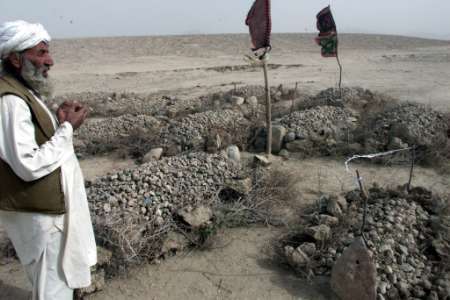
The Value of a Dead Afghan: Revealed and Relative
by Marc W. Herold
Departments of Economics and Women's Studies
Whittemore School of Business & Economics
University of New Hampshire
POSTED JULY 21, 2002 --
On May 7, 1999, a U.S. B-52 bomber dropped three JDAM bombs upon the Chinese Embassy in Belgrade. Three young Chinese journalists were killed and 27 other persons in the embassy were wounded. Four months later, the United States agreed to pay $4.5 million in damages to the families of the deceased and to the injured. This amounts to about $150,000 per victim. When a U.S. marine jet hit aerial tramway cables in Italy not too long ago, the U.S. gave close to $2 million to each Italian victim.
On July 1, 2002, a U.S. AC-130 gunship attacked and strafed four villages in the Deh Rawud district of Uruzagan, killing more than 60 innocent Afghans and wounding about 120 others.1 The American troops which occupied the villages offered tents and blankets as compensation. A week later, the U.S.-installed and backed Karzai regime offered the Afghan wedding victims $18,500 in compensation, or about $100 per victim -- the payments were $200 on behalf of each individual killed and $75 for each wounded person, using Afghan regime figures of 48 killed and 118 wounded.2 Note might be taken that the wedding party victims were Pashtuns [from the same ethno-linguistic group as Karzai, though Karzai does not speak Pashto]. What does seem certain is that the villagers of Uruzgan will now receive a permanent U.S. Special Forces base in their area (as compensation) and the compliant U.S. mainstream media "spins" this as a way of better protecting innocent Afghans from U.S. firepower.
I agree fully with those who argue that attaching a monetary value to a life is an immoral and sordid endeavor and this essay in no way should be interpreted as support for such efforts. I merely wish to show that by the extremely conservative standards of mainstream economics -- and many in Karzai's closest entourage are well-versed in such thinking having been employees of the World Bank and other pillars of international capitalism3 -- the compensation offered by the Karzai regime is paltry and insulting, even far below what should be given using the discounted future earnings approach.
Other figures for compensation have been put forth, for example Global Exchange argues for $10,000 for each family which lost kin -- a very modest amount of about one-fifteenth of that paid the Chinese victims in Belgrade.
By Karzai's accounting standards, the life of a dead Afghan is 'worth' only one-seven hundredth of that of a dead Chinese, one-ten thousandth of a dead Italian and one-thirty thousandth of a dead American -- if her/his life is 'worth' $6,000,000 on average, as the U.S. Environmental Protection Agency has calculated.
The point is sometimes made that cross-country comparisons of monetary values should be made in purchasing power parity (PPP) terms.4 To do this in the Afghan case -- that is to make $18,500 in Afghanistan match an equivalent dollar amount in terms of purchasing power in the United States, would amount to about multiplying the $18,500 figure by five. But in fairness, then we should also translate into U.S. terms the numbers of Afghan civilian deaths from bombing -- estimated at 3,100- 3,600, or in U.S. terms, given a U.S. population 10 times as large, 31,000 - 36,000.
Economists, lawyers and moral philosophers have struggled to assess the 'value of life.' I shall dwell on the attempts by mainstream economists to do this and apply such reasoning insofar as is possible to Afghanistan. Naturally, mainstream economists seek to determine a 'fair' monetary value. Different approaches have been advanced. Recent work argues that the calculation of the value of human life should begin by asking individuals how much they would be willing to extend their life for a finite period of time. This allegedly circumvents the impossible question of evaluating possible death in monetary terms, and rather asking a person to assess the utility of additional years of life which she/he does know. According to a model of Allan Feldman, the amount people are willing to pay to extend their life for a fixed period of time is then roughly equivalent to what the person would spend on personal consumption during that time [note the powerful Western bias here which privileges consumption as the end-all of living].5 Another approach calculates the value of a human life by examining how much an individual is willing to pay to reduce the risk of death by say a certain specified percentage.
The dominant 'model' in practice, however, remains not the neoclassical economists' 'willingness to pay' perspective, but rather the simple old discounted future earnings model which focuses upon human beings as a machine generating a stream of income into the future. What could the deceased have earned? Naturally, such a valuation model contains numerous problems as well: Someone who is 65 years or older or is retired is worth nothing; compensation only encompasses foregone discounted earnings and omits dependents' pain and suffering, etc. Feldman, who proposes the 'willingness to pay' valuation, criticizes the human capital approach because it does not correctly assess what people are willing to pay to avoid death -- it does not count all the other factors than income which people figure into life's enjoyment. The less inappropriate modeling exercise to value a dead Afghan's life will be human capital's discounted lifetime earning stream model. The average life expectancy in Afghanistan is about 43-45 years. We'll assume an average monthly wage of about $30, which in areas like Uruzgan would be a high figure, though appropriate for Kabul. Past calculations have usually assumed a discounting rate of 5% to 10%. The following Table 1 presents the discounted present value of accumulated earnings under different assumptions of future years lived and discount rates:
Table 1. Present Value of Monthly Earnings of $30 in Afghanistan
| Discount Rate | 2% | 5% | 7.5% | 10% | 15% | 20% |
| Years 5 | $1,697 | $1,559 | $1,457 | $1,365 | $1,207 | $1,077 |
| 10 | $3,234 | $2,780 | $2,471 | $2,212 | $1,807 | $1,509 |
| 15 | $4,626 | $3,737 | $3,178 | $2,738 | $2,105 | $1,683 |
| 20 | $5,887 | $4,486 | $3,670 | $3,066 | $2,253 | $1,753 |
| 25 | $7,028 | $5,074 | $4,013 | $3,268 | $2,327 | $1,781 |
Assuming that the persons killed in the raids upon Uruzgan were mostly quite young, let's say on average 15 years old, then remaining working lives would be about 25 years. The present discounted earnings then would be something between $3,300 to $5,000. In February, 2002, the CIA distributed $1,000 to $2,000 to the families of 22 Afghans killed by U.S. Special Forces in Hazar Qadam -- about $5,000 to $10,000 in PPP dollars.
When we make the comparisons in purchasing power parity terms, we find the following:
Table 2. Revealed 'Value' of Life of Different Nationalities
| Nationality | In nominal $'s | GDP PPP$s/GDP US $'s ratio | in PPP US $'s |
| of Italians | $2,000,000 | 1.09 | $ 2,180,000 |
| of Chinese | $ 150,000 | 4.58 | $ 687,000 |
| of Indians | $3,200 | 5.01 | $16,032 |
| of Afghans @ lifetime earnings | $ 3,300 - $ 5,000 | ~5* | $16,500 - $25,000 |
| of Afghans @ Karzai amount | $200 | ~5 | $1,000 |
*The Afghan ratio of 5 is estimated on basis of GDP data and it is close to that for Pakistan where prices are similar, a ratio of 4.25 in Pakistan.
The Afghan figure is a fraction of what compensation was paid for Italian and Chinese lives lost to U.S. official negligence, though almost identical to the paltry amount offered by Union Carbide to the Indians. In the Bhopal chemical disaster, a final compensation settlement was reached totaling $470 million -- an average of $3,200 for each death and $870 for each person injured.
In 1984, the Wall Street Journal's Barry Neuman wrote that Indians don't expect compensation for lives lost in the Bhopal poisonous gas leak because "the certainty of reincarnation satisfies the Hindus; for the Moslems, what God wills, God wills."6 The Times of India caustically noted that about $40,000 was spent on the rehabilitation of every sea otter affected by the Exxon Valdez oil spill in Alaska.7
But what is even more instructive in the Afghan case, is that the Bhopal figures are 15 to 25 times what the Karzai regime has offered as compensation for a Pashtun life. An argument could be made that those who did the killing, the United States military, should compensate the victims. But the U.S. government will not officially admit wrongful death resulting from its aerial bombing in Afghanistan -- as this would undermine its posturing about precision attacks. Hence, the U.S.-backed Karzai regime functions as a de facto conduit for any compensation.
The relatively low value put by Karzai upon the lives of his fellow Pashtuns is further demonstrated by the regime's acquisition of $60,000 a piece fully-loaded Toyota Land Cruisers for regime luminaries -- like vice president Abdul Qadir who died in a dark green model.
Ultimately, a Toyota Land Cruiser is revealed to be worth 300 times more to Mr. Karzai than the life a fellow Pashtun!
-- 30 --
Footnotes
1. For details see Marc W. Herold, "Crashing the Wedding Party: Arrogance, Pentagon Speak and Spooky's Carnage" [July 8, 2002] at http://www.cursor.org/stories/kakarak.htm
2. "Afghan Wedding Victims Get $18,500 in Compensation," Times of India [July 8, 2002] citing Agence France-Presse; and "Wedding Party Victims $18,500 in Compensation," The News [July 8, 2002]. Noises were made during the past week that the U.S. Government was thinking of offering $2 million in compensation, but these rumors were denied . "U.S. to Compensate Afghans: Report," Reuters [July 11, 2002 at 04:42 P.M.]. Most troubling was the idea that the monies would be distributed to the families by the Karzai regime, meaning that a portion would certainly not reach the victims.
3. For details on the vision of reconstruction of the Karzai regime, see Marc W. Herold, "Karzai & Associates' Trickle-Down Reconstruction" [May 12, 2002] at http://www.cursor.org/stories/karzai.htm
4. For a definition of such, see "What is Purchasing Power Parity?" at http://pacific.commerce.ubc.ca/xr/PPP.html
5. Allan M. Feldman, "The Value of Life Revisited," The Value of Life Revisited" [Providence, R.I.: Department of Economics working paper 96/2, Brown University, 1996].
6. Barry Neuman, "Death in Bhopal: Compensation Seems Not Quite the Point," Wall Street Journal [December 19, 1984]: 1, 20.
7. Times of India cited in "Bhopal Gas Tragedy. The Economic and Legal Aspects," at www.geocities.com/Athens/Forum/8266/Bhopal-3.htm
